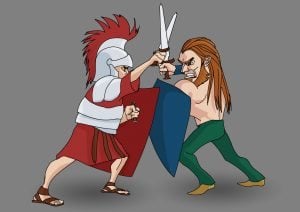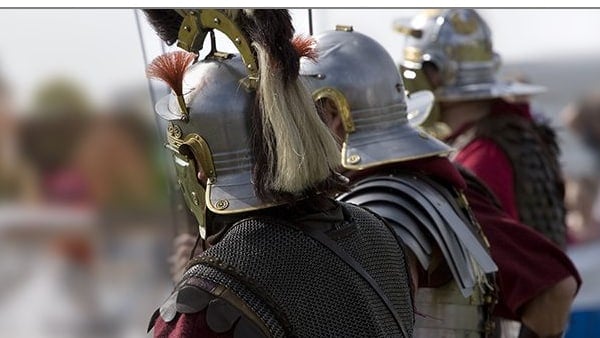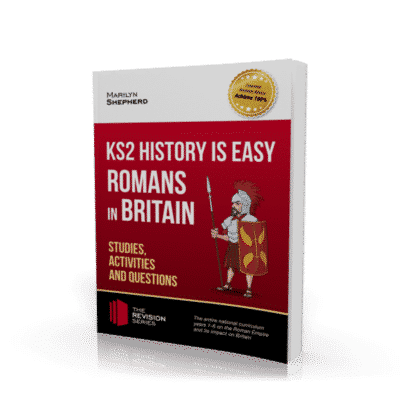Here at How2Become we’ve published a fantastic series of books. Designed to improve the process of learning, our KS2 History books are a surefire way for any pupil to brush up on their history knowledge, in a fun and interesting way. To start with, let’s look at some Roman facts for Kids
Who Were The Romans?
Ancient Rome was an amazing civilisation which lasted for over 1000 years – from around 750 BC (Before Christ – who we say was born in the year 0) to the year 476 (around 1500 years ago).
During this time, the Romans were responsible for huge amounts of political progress and technological development, thinking of many ideas and inventions that we still use today!
What Were Roman People Like?
However, the Romans did have a ruthless and barbaric side to them. They enslaved thousands and had a love of blood sports like gladiator fighting. The Romans used their incredibly strong army to enforce its will. This army was so successful, that the main reason for the fall of the Roman Empire is that it took over too much land and became too big to rule over! Before the Romans had an empire, they had a fairly efficient system of government! The system of senators and governors inspired the democracies seen in many countries today. At the peak of their power, the Romans controlled most of Western and Central Europe, including large parts of North Africa and the Middle East. They were able to take over this land by invading and defeating other powers.

The Seven Kings of Rome
Ancient Rome was a special civilisation, in that it saw many different types of leadership and rule. Throughout this period, Rome saw everything from kings, to a government, to emperors. You might immediately think of emperors when discussing ancient Rome, but there were hundreds of years of kingly rule and republicanism even before the empire started.
King 1 – Romulus
- As the founder of the city, Romulus declared himself the first king of Rome.
- His first task as king was finding some subjects, as very few people lived in his city at the start!
- To fix this, he invited the leaders of the surrounding towns and villages to send their most undesirable citizens to Rome.
- Soon the city was bustling, even if it was with thieves and troublemakers.
- Romulus then divided his citizens into two groups – those who could fight, and those who could not.
- Out of those who could not fight, Romulus chose the most suitable few and formed the Senate – a sort of government to assist the king – although Romulus had absolute power.
- The citizens who could fight formed the first Roman army, which Romulus used for many successful war campaigns in his 40 years of rule.

King 2 – Numa Pompilius
- The reign of the second king of Rome, Numa Pompilius, was a peaceful and religious one.
- During his 43 year rule, Numa constructed many sacred temples, and did much to enshrine the belief and worship of many Gods that would become the Roman tradition.
- This included introducing the earliest religious ceremonies and holy artefacts.
- Numa was a very well-respected king whose wisdom and peace efforts were long revered.
King 3 – Tullius Hostilius
- The next king, Tullius Hositilius, had a very different style of leadership to his predecessor.
- Unlike Numa Pompilius, the focus of Tullius’s reign, which lasted 32 years, was on war and expanding Rome’s territory.
- His biggest success was when he conquered the nearby ancient city of Alba Longa (where Romulus was said to have been born).
- This was important because Alba Longa was an ancient and influential city, so a Roman victory showed how powerful they had become, and in such a short space of time.
King 4 – Ancus Marcius
- Tullius’s successor again changed Rome’s priorities.
- Ancus Marcius, Rome’s fourth legendary king, focused on trade and making Rome an economic power.
- Ancus also oversaw a huge growth in Rome’s size and territory, including taking over sea ports for international trade.
King 5 – Tarquinius Priscus
- By the time of Tarquinius Priscus’s reign, Rome was a major power in what we now call Europe.
- Tarquinius reigned for around 40 years, and is most remembered for increasing the senate by 100 members, and constructing the Circus Maximus where chariot races were held! In another sporting move, Tarquinius established the public games.
King 6 – Servius Tullius
- Servius Tullius ruled for about 45 years, during which time he led a number of successful military campaigns.
- This made Rome even more rich and influential. In addition to this, Servius built many holy temples in an attempt to make Rome one of Europe’s spiritual hubs.
- However, Servius’s most lasting legacy was arguably the huge wall he constructed around the 7 hills of Rome. It was called the Servian Wall, after himself.
King 7 – Tarquinius Superbus
- The last of the legendary seven kings was named Tarquinius Superbus.
- It was Tarquinius who brought an end to the previous king’s reign by plotting against him and having him killed!
- He managed to take the throne for himself, but he was not very popular with the Roman people; he was a cruel and ruthless tyrant.
- This was made worse when Tarquinius began to undo some of the good work of previous kings, which included the demolition of sacred temples.
The End of the Ancient Roman Kingdom
Although his reign lasted around 25 years, Tarquinius eventually became so unpopular that the citizens of Rome staged a revolt! They managed to overthrow the bloodthirsty king, and set up their own political system – a system of government with no king! This was the start of the Roman Republic.
Want more Roman facts for kids?
How2Become have produced a fantastic study guide. Jam packed with essential information about Ancient Rome, this is the ULTIMATE resource for anyone studying KS2 Roman History.


